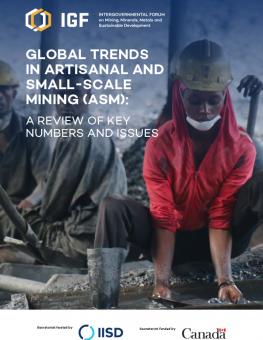
Global Trends in Artisanal and Small-Scale Mining (ASM): A review of key numbers and issues
IGF and IIED recently launched this report highlighting how rising mineral prices and the struggle to earn a living from agriculture have led to explosive growth in ASM.
Global Trends in Artisanal and Small-Scale Mining (ASM): A review of key numbers and issues was prepared by the International Institute for Environment and Development (IIED) for the Intergovernmental Forum on Mining, Minerals and Sustainable Development (IGF).
ASM has experienced explosive growth in recent years due to the rising value of mineral prices and the increasing difficulty of earning a living from agriculture and other rural activities. An estimated 40.5 million people were directly engaged in ASM in 2017, up from 30 million in 2014, 13 million in 1999 and 6 million in 1993. That compares with only 7 million people working in industrial mining in 2014.
ASM is generally pursued as a route out of poverty or as an activity to complement insufficient income, especially in communities where alternative employment is hard to come by. ASM is also a very diverse sector. Its main challenges vary from region to region—and often from site to site.
There is a perception that ASM is a “get-rich-quick” activity. This has misinformed legislation and extension programs and led to the application of one-size-fits-all policies. However, people working in ASM are far from the same. They range from those whose livelihoods rely on subsistence farming to skilled workers who migrated from urban areas in search of work.
Despite its low productivity, ASM is an important source of minerals and metals. It accounts for about 20 per cent of the global gold supply, 80 per cent of the global sapphire supply and 20 per cent of the global diamond supply. ASM is also a major producer of minerals indispensable for manufacturing popular electronic products, such as laptops and phones. For example, 26 per cent of global tantalum production and 25 per cent of tin comes from ASM.
Additional downloads
You might also be interested in
Mining Policy Framework Assessment: Bhutan
Identifying policy strengths, gaps, and recommendations to enhance mining governance in the country.
State of the Sector: Critical energy transition minerals for India
This report presents a comprehensive strategy for securing a reliable supply of critical energy transition materials (CETMs) essential to India's clean energy and low-carbon technology initiatives.
Gender-Responsive Mining Policies
This publication presents case studies detailing gender-responsive mining policies that support skills, employment, and inclusive governance.
Artisanal and Small-Scale Mining of Critical Minerals
This report examines the potential for artisanal and small-scale mining (ASM) to take an expanded role in the global supply of critical minerals.